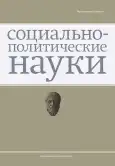The Formation of China’s Diplomacy and its Features
- Authors: Liu X.1, Liu Z.1
-
Affiliations:
- St. Petersburg State University
- Issue: Vol 13, No 1 (2023)
- Pages: 155-162
- Section: International Relations, Global and Regional Studies
- URL: https://journals.eco-vector.com/2223-0092/article/view/545890
- DOI: https://doi.org/10.33693/2223-0092-2023-13-1-155-162
- ID: 545890
Cite item
Abstract
The authors of this study aim to highlight the features of the formation of Chinese diplomacy and the formation of China’s foreign policy in modern times. The authors analyze three periods of the formation of the diplomacy of the People’s Republic of China – “diplomacy of peaceful liberation” (1921–1949), “diplomacy of peaceful coexistence” (1949–1979) and “diplomacy of peaceful development” (from 1979 to our time). The conclusions reached by the authors indicate that China’s diplomacy developed in a unique way and undoubtedly reflected the historical changes that took place with the state. All three stages have had an important impact on the formation of Chinese diplomacy, bringing their own nuances to the modern diversity. Thus, among the most important areas can be distinguished – economic diplomacy, multilateral diplomacy, cultural diplomacy, cooperation and protection of the main national interests, that is, the foundations that emerged due to the historical transformation of the state. According to the authors, solving problems and improving the country’s image will remain an important characteristic of Chinese diplomacy, especially in its relations with other major powers. In cooperation with other major powers, China is likely to be more active in solving fundamental global problems at the strategic level. China does not seek to change the international system, rather, it intends to be a responsible participant in world affairs. As China’s identity becomes more global and regional, the current concept of multilateralism in China’s overall diplomatic strategy may be revised to realize national interests, resolve complex issues and ensure governance in an era of instability and turbulence.
Full Text
About the authors
Xiao Liu
St. Petersburg State University
Email: 1298054443@qq.com
postgraduate student
Russian Federation, St. PetersburgZhaoyi Liu
St. Petersburg State University
Author for correspondence.
Email: liuzhaoyie@gmail.com
postgraduate student
Russian Federation, St. PetersburgReferences
- Bogdanova N.A., Solntseva E.G. Mao Zedong and the formation of a diplomatic strategy “to stick to one side”. Modern Scientific Thought. 2018. No. 6. Pp. 158–162. (In Rus.)
- Bogdanova N.A., Solntseva E.G. Features of Deng Xiaoping’s diplomatic course. Historical, Philosophical, Political and Legal Sciences, Cultural Studies and Art Criticism. Questions of Theory and Practice. 2018. No. 2. Pp. 10–14. (In Rus.)
- Zedong M. About the democratic dictatorship of the people. On the 28th anniversary of the founding of the Communist Party of China (June 30, 1949). URL: http://library.maoism.ru/demdic.htm
- Juntao V. Features of public diplomacy of the People’s Republic of China (historical aspect). Russia in the Global World. 2021. No. 21 (44). Pp. 67–80. (In Rus.)
- Tsimin Ts. The five principles of peaceful coexistence remain relevant in the XXI century. 28.06.2014. URL: https://www.belta.by/interview/view/pjat-printsipov-mirnogo-sosuschest vovanija-sohranjajut-aktualnost-v-xxi-veke-4127?ysclid=lalc 5miuhh479306650
- Shanin M. Celestial Hundred. Why China shot peaceful demonstrators and why it tries to forget about it. 04.06.2019. URL: https://lenta.ru/articles/2019/06/04/tiananmen/?ysclid=ldfx 5kt683978545109
- Baiyi W. The Chinese security concept and its historical evolution. Journal of Contemporary China. 2010. № 10 (27). Pp. 275–283. doi: 10.1080/10670560124748.
- Carlyle A.T. China’s “New Security Concept” and Southeast Asia. 2003. Pp. 89–107. doi: 10.22459/APS.05.2013.08. URL: https://press.anu.edu.au/downloads/press/p239321/pdf/ch085.pdf
- China’s 40 years of reform and development 1978–2018. R. Garnaut, Ligang Song, Cai Fang (eds.). Published by ANU Press The Australian National University Acton ACT 2601. Australia, 2018. 679 р.
- d’Hooghe I. China’s Public Diplomacy. Brill Nijhoff, 2014. 442 р.
- Ge S. The great historic journey of Chinese diplomacy. China International Studies. December 15, 2017. URL: https://www.ciis.org.cn/english/ESEARCHPROJECTS/Articles/202007/t20200715_3607.html
- Palit P.S. China’s cultural diplomacy: Historical origin, modern methods and strategic outcomes. China Currents. 2013. No. 2. Vol. 12. A Center for Collaborative Research & Education on Greater China. URL: https://www.chinacenter.net/2014/china_currents/12-2/chinas-cultural-diplomacy-historical-origin-modern-methods-and-strategic-outcomes/
- The Chinese government’s eight principles for economic aid and technical assistance to other countries. January 15, 1964. Wilson Center. Digital Archive International History Declassified. URL: https://digitalarchive.wilsoncenter.org/document/121560
- Umezinwa P.P. Future trends of China’s diplomacy. 2019. URL: https://moderndiplomacy.eu/2019/10/17/future-trends- of-chinas-diplomacy/
- Yang J. China’s diplomacy: Theory and practice. World Century Publishing Corporation, 2014. 557 р.
- Zhang J. China’s faith diplomacy: Initiatives and vulnerabilities. In: Essays on faith diplomacy. N. Leight (ed.). 2011. 88 р. URL: https://www.researchgate.net/publication/258510066_China’s_faith_diplomacy_Initiatives_and_vulnerabilities
Supplementary files











